 |
||
|
||
| ||
MOJO 1, MOJO 256F, MOJO 128F and MOJO X — TDK´s new portable MP3 players Olympus unveils underwater case for C-5060 DVD+RW Alliance demonstrates dual-layer DVD+R Toshiba introduces the first working 90nm silicon on X Architecture Fujitsu to manufacture 90nm Transmeta Efficeon processors Delkin announces 32-bit CardBus adapter for CF cards MOJO 1, MOJO 256F, MOJO 128F and MOJO X — TDK´s new portable MP3 players TDK introduces four exciting new MOJO(TM) MP3 players, the next generation of the company´s highly acclaimed MOJO portable audio line: MOJO 1, MOJO 256F, MOJO 128F and MOJO X. 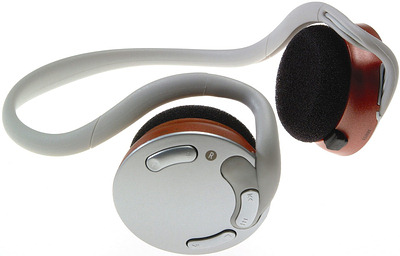 MOJO 1 — with 128MB of built-in memory and support of virtually all bit rates (8-320 kbps including variable bit rates), it´s the ideal player for MP3 and WMA files. A memory card slot (MMC and SD card compatible) enables memory expansion. By selecting one of the 25 programmable FM tuner presets, you are instantly in touch with music, news, sports and weather. MOJO 1 has an audio output, which enables sharing music with a second set of headphones or playing the unit through a home stereo or mini-system. MOJO 1 delivers up to 10 hours of playback from its included AAA battery and is supplied with a user´s guide, a USB cable, a software CD-ROM and three sets of ear covers for long-lasting performance. MOJO 1 will be available in October 2003 at an estimated street price of $179.99. 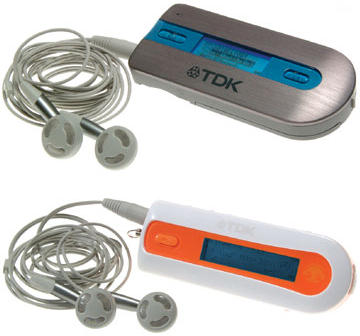 Pocket-sized MOJO 256F, MOJO 128F and MOJO X feature MP3/WMA playback and support variable bit rates up to 320 kbps for the highest audio playback quality. MOJO 256F — MP3 player for a wide range of applications from the backyard to the boardroom. Combining a digital FM tuner, 256MB of internal memory, and an MMC/SD memory card slot, MOJO 256F delivers large storage capacity, expandability and superior portability. MOJO 256F is capable of recording voice memos and FM radio to its memory, and includes text-to-speech software for anywhere, anytime review of your text files.The FM tuner features 20 programmable presets providing instant access to favorite radio stations. MOJO 256F delivers up to 12 hours of playback from its included AAA battery and is supplied with a user´s guide, a USB cable, and a software CD-ROM. For total comfort and convenience, MOJO 256F comes with ear-bud style headphones and a carrying case that provides extra player protection. MOJO 256F will be available in October 2003 at an estimated street price of $189.99. MOJO 128F — designed for the music lover, its 128MB of internal memory, memory expansion slot (MMC and SD card compatible), and digital FM tuner make MOJO 128F a serious personal music machine. MOJO 128F is also capable of recording voice memos and FM broadcasts to its internal memory and features 20 programmable FM station presets. Like its sibling, the MOJO 256F, the MOJO 128F features a backlit text display, simple-to-use controls and versatile playback options, including seven EQ presets and four playback modes. MOJO 128F also includes TDK´s UniFi track transfer software and plug-ins for other popular track transfer applications (RealOne Player, Windows Media Player, MoodLogic and Apple iTunes). MOJO 128F comes with ear-bud style headphones, a carrying case and AAA battery, providing up to 12 hours of music enjoyment. MOJO 128F will be available in October 2003 at an estimated street price of $139.99. MOJO X is a simple player, featuring 128 MB of internal memory. It features five equalizer presets (normal, jazz, pop, rock and bass) plus a user-programmable EQ mode to "dial-in" the right sound for your style of music. To further increase your listening options for total sonic satisfaction, MOJO X incorporates repeat 1/all and A-B playback modes. MOJO X comes with ear-bud style headphones, a carrying case and AAA battery, providing up to 12 hours of anytime, anywhere music enjoyment. MOJO X will be available in October 2003 at an estimated street price of $99.99. Olympus unveils underwater case for C-5060 The recently announced Olympus CAMEDIA C-5060 Wide Zoom already got additional case for underwater shooting. We´ve written about the C-5060 official announcement just a week (see C-5060 Wide Zoom — new 5 megapixel camera from Olympus) and today the company introduced the PT-020 underwater option along with the FL-20 flash and its PFL-01 underwater case. Besides, the the company prepares new wide-angle (17mm) WCON-07C optics with CLA-7 adapter that will be marked PPO-02 in the underwater variant. Anyway, we´ll have to wait until November, when C-5060 and underwater options are available for sale.
 The PT-020 case allows dives down to 40m, while the FL-20 flash (with PFL-01) even supports TTL underwater.
 The only thing left is pricing (only for Japan for now): PT-020 case for C-5060 will cost about $250, FL-20 (already available) – $130, PFL-01 case for FL-20 — $250, PPO-02 wide-angle lens – about $150.
 Source: PC Watch
DVD+RW Alliance demonstrates dual-layer DVD+R Philips will demonstrate its new dual-layer DVD recordable technology at the DVD+RW Alliance booth at the CEATEC JAPAN 2003 exhibition. Developed by Philips Research in cooperation with MKM (Mitsubishi Kagaku Media)/Verbatim, the technology virtually doubles data storage capacity on DVD recordable discs from 4.7 Gbyte to 8.5 Gbyte while remaining compatible with existing DVD Video players and DVD-ROM drives. Users will benefit from the additional storage capacity of the DVD+R disc as it will enable them to record 4 hours of DVD-quality video or 16 hours of VHS-quality video, without the need to turn over the disc. PC users will be able to archive up to 8.5 Gbytes of computer files on a single disc, which almost doubles the storage capacity compared with the 4.7Gbytes for the single-layer DVD+R discs currently available. The dual-layer DVD+R system uses two thin embedded organic dye films for data storage separated by a spacer layer (see figure). Heating with a focused laser beam irreversibly modifies the physical and chemical structure of each layer such that the modified areas have different optical properties to those of their unmodified surroundings. This causes a variation in reflectivity as the disc rotates to provide a read-out signal as with commercially pressed read-only discs. 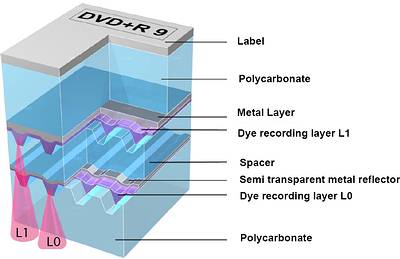 Initial investigations were started by Philips Research around 2 years ago at a time when there was general scepticism throughout the optical storage industry that compatible dual-layer DVD recordable would ever be possible. Developments since then, initially by Philips and later in cooperation with media manufacturer MKM, have dispelled this scepticism and the new dual-layer DVD+R technology is now fully endorsed by the DVD+RW Alliance. The DVD+RW Alliance is setting an aggressive feature and performance roadmap, and the dual-layer DVD+R format book is expected to be ready within this year. Recorders for both the PC and consumer electronics markets are expected to become available during the course of 2004.
Toshiba introduces the first working 90nm silicon on X Architecture 
The "X Initiative" group created in Summer 2001 to advance the technology of diagonal connections between metallization layers in chip production announced that Toshiba , a permanent member of this group, released the first 90nm silicon on this architecture. The idea of the new technology bases on creating special blocks (tiles) with diagonal connections created by the "liquid routing" technology to provide effective diagonal routing inside a block. Then tiles are joined using usual orthogonal connections. The tile concept itself was developed by ArTile, Toshiba´s daughter compan, in 2001. Today the industry usually utilizes the "Manhattan" rectangular layouts. Toshiba´s experimental chips with 5-layer metallization were produced at the proprietary experimental 90nm fab using standard equipment and materials. They especially underline that comparing to the usual "Manhattan" technology X Architecture reduces connections length by 14%. I´ll just add that Toshiba schedules X Architecture volume production in 2004. As for the X Initiative group, currently it includes enough industry leaders like Applied Materials, ARM, Artisan Components, ASML, Cadence Design Systems, Dai Nippon Printing, DuPont Photomasks, Applied Materials, Leica Microsystems, Matsushita Electric Industrial, Nikon, Sanyo Electric, Silicon Valley Research, STMicroelectronics, Toppan Printing, Toshiba, etc. For more information visit the
X Initiative website.
Fujitsu to manufacture 90nm Transmeta Efficeon processors An interesting fact: Transmeta announced the new contract manufacturer for its next-generation processors. We know now that new 90nm chips codenamed Transmeta Efficeon will be produced by Japanese Fujitsu. Despite that we´ve already mentioned Efficeon chips (former Astro; TM8000 according to company´s internal marking), the official annoucement will take place only next week, October 13-16 at In-Stat/MDR Microprocessor Forum (MPF) in San Jose, CA.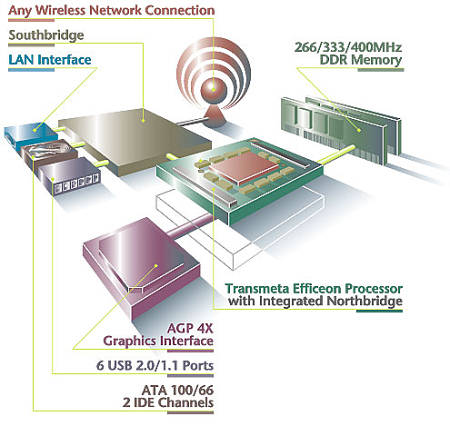 It´s hard to name a univocal reason for Transmeta to change manufacturer from the usual TSMC to Fujitsu. They say that TSMC could only offer Transmeta 0.13µm process for Efficeon (chips will be announced in this process first). The first processor expected in volumes will have the 1.1GHz clock speed and the first notebooks should arrive in Q4 2003 already. Perhaps, besides more prospects of Fujitsu technologies, it was also important for Transmeta that before TSMC has often delayed the volume production. At least seeing the over a half-year delay of Crusoe TM5800 Transmeta often complained about the manufacture partner. Anyway, 90nm Efficeon volume production is scheduled to H2 2004. For this Fujitsu plans to port the chip design to own 90nm CS100 process technology. At that, according to the provisional information, transistor gate length will make 40nm in 11-layer design. The manufacture will be established in Fujitsu Akiruno Technology Center nearby Tokio. As for the current 0.13µm Efficeons produced by TSMC, we know that they´ll be tested and packed by Advanced Semiconductor Engineering (ASE).
Delkin announces 32-bit CardBus adapter for CF cards Delkin Devices Inc. has introduced a PCMCIA adapter, CardBus 32-bit PCMCIA that is four to six times faster than all current conventional 16-bit adapters. The CardBus 32 adapter allows CF memory cards to work in the PC Card slot on most Windows based laptops and uses the high speed CardBus PCMCIA standard. The new Delkin 32-bit CardBus adapter has the same size, shape and design as existing 16-bit adapters in common use now. The adapter inserts completely within its host without any external cabling and operates at a power-saving 3.3 volts, extending battery life in most configurations. 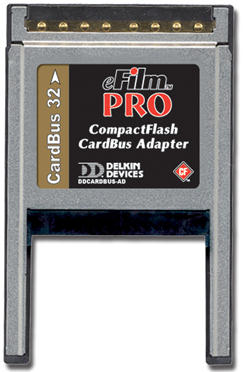 Although labelled eFilm PRO, the adapter can be used with CF cards from other manufacturers. The Delkin CardBus 32 adapter has a theoretical maximum speed of 132MB/s. Speed in real world applications is determined by the speed of the CPU and flash chips within the CF card. High-speed cards like the Delkin eFilm PRO and the IBM Microdrive will operate much faster than other cards not designed to be high speed. Tests, performed by Delkin´s engineers, on eFilm PRO cards and other high-speed CF cards revealed similar speed increases of four to six times that of standard 16-bit CF adapters. 100 Megabytes of JPEG photos on a Delkin PRO card were transferred to a Dell laptop with both a Delkin 16-bit adapter and the new CardBus 32 adapter. The CardBus adapter took 18 seconds (5.5MB/s) to transfer the images and the standard adapter took more than four times as long, taking one minute, 26 seconds (1.16MB/s) to transfer. Delkin CardBus 32 adapters also utilize a patented chip, which reduces the burden on the host CPU to 10% or less, further increasing the value of this product. The Delkin CardBus 32 adapter is currently shipping with a retail price of $59.99.
Write a comment below. No registration needed!
|
Platform · Video · Multimedia · Mobile · Other || About us & Privacy policy · Twitter · Facebook Copyright © Byrds Research & Publishing, Ltd., 1997–2011. All rights reserved. |